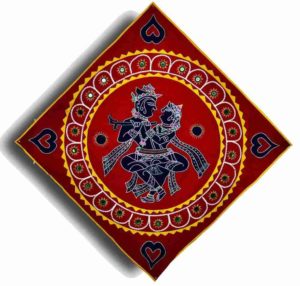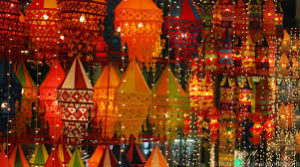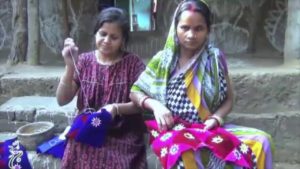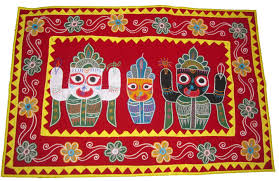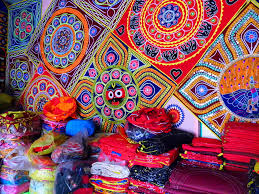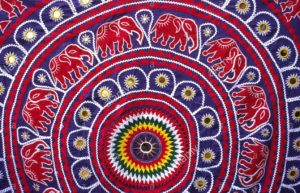Trees might be felled, animals might go extinct, folklore might perish, but nature and its irresistible grandeur will never cease to exist as long as the appliqué craft of Odisha’s Pipili is alive with its fabric, threads and stitches.
Pipili, a petite village located in the fringes of Puri district of Odisha, India, could have remained largely inconspicuous, had it not been for its extraordinary appliqué Handicraft. But Pipili, with its creative brilliance of applique, stands out like a shining star on an otherwise modest horizon. As soon as you step into the soil of Pipili you get bewitched by the bold colours, enchanting designs, glimmering mirrors and shimmering sequins. As if paradise has been regained, where every burden of the monochromatic mundane becomes a figment of the past and all we see, smell and sense is a harmonious mélange of colours, crafts and creative expressions. Such is the exuberance of Pipili’s Applique handicraft.
Pipili’s applique– A brief round tour
The word “appliqué” originates from the French word” appliquer” , which means “to put on”. As the name suggests, this art work is brought to life by superimposing small patches of coloured fabric on the large surface of a vibrant base cloth and then sewing the edge of the patches with intricate stitches. In lay man’s words, appliqué is the technical term for patchwork art. Applique handicraft thrives in various parts of India like Rajasthan, Bihar, Gujarat, etc , but Odisha’s Pipili commands a higher level of authority in this form of art. It’s because appliqué with all its beauty and brilliance originated in Pipili, took the shape of small-scale appliqué cottage industry and became the sole source of livelihood and survival for the people of this place, who are mostly craftsmen. It is owing to the origination of unique techniques of stitchery, adherence to certain conventional methods of craft and a complete dedication to appliqué art that Odisha’s vibrant Pipili is bejeweled with the nickname of applique village of India. Pipili wears the sobriquet as its hard-earned and well-deserved pride.
Applique handicraft of Pipili, Odisha also went on to bag a geographical indication (GI) by the govt. of India. In addition to this, it made a place in the “2004 Limca book of records for the world’s largest thematic appliqué work, a 54 metre long work filled with depictions of India’s Independence Struggle.”(Wikipedia). Thus, appliqué handicraft of Pipili achieved international repute with time and Pipili, due to the virtue of its stupefying products, got-thronged by a sea of travelers visiting the nearby tourist destinations.
Birth of Applique: A Religious Beginning
The origin of Pipili’s appliqué work, fondly referred to as ‘Chaandua’ in Odia language, dates back to times as ancient as the 11th century AD and is directly connected with the customary rituals of The Lord Jagannath temple of Puri. Pipili’s craftsmen, more colloquially referred to as ‘tailors’ or ‘darzis’, were endowed with the responsibility of supplying colourful stitched material like canopies, umbrellas and fans to be used in the elaborate festivities of Lord Jagannath, the most noteworthy of them being the car festival. In the world-famous car festival, the chariots of the trinity Gods (Lord Jagannath, Balabhadra, Subhadra) are decorated with vibrantly coloured fabric embellished with appliqué stitches and patchworks. The chariots, which are huge and gargantuan, get further emboldened by the lavish covers of appliqué. No doubt the internationally known car festival is one of the major events that made the story of Pipili’s patchwork reverberate across the globe.
Patterns, Process & Products
Pipili’s handicraft techniques are primarily based on an array of stitches, strips and patchworks. All the appliqué patterns developed on the fabrics is a permutation and combination of these three techniques. Most popular patterns include motifs replicating essential elements of nature like plants, leaves, flowers, birds, animals, mythical and mythological characters like Rahu (the monster who ate Sun God and became responsible for a total eclipse, according to Hindu scriptures). Such a colorful rendition of mother earth on the surface of silk, cotton and velvet fabric with bright, blazing and beautiful patterns is indeed praiseworthy. It speaks volumes about the culture-sensitive history of Odisha and its resplendent heritage.
Further, this flashy craft of applique involves the toil of both the men and women folks of Pipili, and therefore the appliqué cottage industry functions on a perfect division of labor between both the genders. While the men of the families are involved in the initial stages of the work like purchasing material, cutting, designing, etc, the more nuanced part of the projects like stitching and finishing are done by the women. Finally, the onus of marketing and sale of the finished products lie on the shoulders of the men who run the shops/stores in bazaars and deal with the regular customers apart from the fixed commercial clientele (bulk buyers).
As far as Pipili’s handicraft products are concerned, they are various and multifaceted. What began with canopies, shamianas and umbrellas meant for the religious ceremonies of Lord Jagannath, gradually pushed its boundaries with the passage of time and turned quasi-religious in nature. From time-honored potli bags, lampshades, basic decor pieces like wall & door hangings to more modern items like tablecloths, cushion covers, shopping bags, etc Pipili’s appliqué artists have done significant addition to their repertoire thereby upgrading their commercial standards and significance. Moreover, the appliqué craftsmen have extended the spectrum of their products by including contemporary stuff like skirts, jackets, hand fans, clutches, envelopes and folders in their potpourri. Such a steady growth has helped them attract the postmodern crowd and stay relevant in rapidly evolving times. Moreover, the introduction of intricately cut mirrors, sequins, silken threads by the patchwork artists, which were prohibited originally, has added a refreshing dimension to Applique. Such advancement has gone a long way in enhancing the quality of Pipili’s handicraft products and in arresting the attention of passersby. Foreign visitors vacationing in Puri, the Pilgrim City of Odisha, make sure to take a peek into this gorgeous village that buzzes with an artistic vibe and own a heirloom piece of appliqué handicraft to elevate the ambiance of their living rooms, work spaces and studios.
Pipili’s Applique: The Ebb & Flow
Pipili’s Applique had flourished in the era of kings, rulers and rajahs, who were connoisseurs of authentic art forms. Unique handicrafts like Appliqué, Pattachitra paintings, terracotta, etc appealed to their discerning palate and they were the ones who used it extensively in beautification of their castles and palaces. Pipili’s appliqué handicraft, apart from serving the religious requirements of Lord Jagannath Temple, provided good amount service to the royal families across India. But, post independence when the royal patronage ceased, the market condition of and the overall appreciation for Pipili’s Appliqué work started to take a nosedive. Colonialism had shifted people’s interest towards more contemporary forms of art and like many others, Applique too suffered and languished due to a lack of love. Certain sturdy steps were taken by the State Government to ensure that such an authentic art form doesn’t die a natural death.
“The production and marketing of appliqué is controlled by the Govt. of Odisha Directorate of Handicraft & Cottage Industries. The Orissa State Co-Operative Handicraft Corporation Ltd., was established in 1959 to market the products of the artisans of the State…with the objective to procure products of the artisans and to expose them to market channels in different area.”(anthro.ox.ac.uk, by Bonani Samal).
The artisans are updated periodically through government sponsored training programs. They are also given State sponsored exhibition platforms to market their skills and display their stock of work. Although the efforts put by the government sounds lucrative, yet they are not enough to keep the creative spirit of hardworking craftsmen up and running. Nevertheless, appliqué artists of Pipili have been upgrading their work in order to match the fast changing aesthetic demands of people and expand their reach to a much wider pool of customers. With all the backbreaking work, appliqué has certainly succeeded in carving a niche for itself.
Epilogue: A Word to Remember
Apart from applauding for the hardships these skillful and laborious craftsmen go through in their struggle to protect this traditional form of handicraft, we can always take that extra mile in boosting the morale of appliqué artists and showing our love for their creativity. By paying a visit to this kaleidoscopic village of Pipili every time we are nearby, by purchasing a designer piece to preserve for the posterity, by extending a note of sincere appreciation to the craftsmen, by enlightening our children and acquaintances about such a rare form of art, we can do our bit in conserving this unique South Asian beauty.
…because Pipili’s appliqué or more appropriately ‘Pipili Chaandua” is much more than a mere motley of colours.
…because Pipili’s Applique Handicraft is one of the testimonies of the throbbing creative culture of India in particular and southasia in general.

